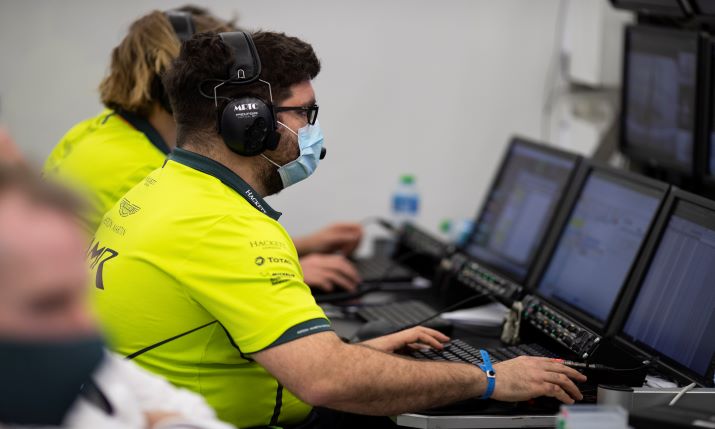A driving force: Clear-Com explores the acceleration of intercom and motorsports innovation
 By Chris Willis, Clear-Com senior vice president of sales.
By Chris Willis, Clear-Com senior vice president of sales.
The motorsports market is a thriving and rapidly growing industry that attracts and thrills a passionate global fan base and auto-enthusiast communities. The exhilarating series ranges across Formula 1, MotoGP, Superbike racing, touring car races, motocross, NASCAR and competitions with snowmobiles (in fact practically anything motorised that moves). This includes Extreme E, an all-electric off-road racing series promoting sustainability by racing in remote terrains to raise climate awareness. As I reflect over the past year and consider the years ahead, the future of motorsports is certainly being shaped by technological advancements and innovative developments, including autonomous technology and the growing popularity of electric and hybrid vehicles.
Complementing advances in technology, the use of intercoms in sports has evolved considerably over the years and it’s evident that communications is and always will be an essential part of motorsports. We’ve certainly come a long way from when teams simply held up pit boards to pass info to drivers. Clear and efficient communication between drivers, co-drivers, pit crews, the engineering team and the central hub, factory or HQ (in an often extremely high energy and noisy environment) is critical for a successful race – allowing the entire team to stay connected and co-ordinate their actions and strategy seamlessly.
Intercom is going beyond its typical borders and fostering communication and collaboration between all disciplines of people who participate in these events, helping to solve complex issues and fostering collaboration. The environment in motorsports is demanding to say the least, and when it comes to communications, sports teams are pushing the limits. Whether we’re thinking about radio frequency spectrum management or how well a wireless beltpack works in rigorous and stressful environments and can roam between transceivers, the development in motorsports is ultimately keeping intercom system manufacturers innovating, stretching our goals and propelling us forward.
IP intercom technology trends
Intercom is continuing its shift towards IP, providing the ability to send comms signals over a local or wide area network, or even the public internet. The beauty of IP is that it offers flexibility, extremely high audio quality and enhanced bandwidth. These benefits allow comms connections between offsite people, various team personnel and facilities, and the track crew.
Upgraded sites are typically outfitted with network-ready cabling, so bringing in an IP intercom system without major infrastructure upgrades can be quite straightforward. Intercom now goes beyond simply connecting the drivers and the pit crews; it’s about more engagement – communicating with the offsite engineering team – whether it be engine timing or software upgrades, the applications are vast. Race engineers and team leads who are hugely integral to a driver’s success can now get directly involved with remote engineering teams to communicate how the car is handling and deliver instructions on remote upgrades and adjustments.
Whether it’s point-to-point or one-to-many (group) connections, or even connecting to existing two-way radios, wired, or wireless systems, IP intercom has revolutionised the way teams communicate on-site and remotely. As an example, the offsite engineering team can run data simulations and feed the information back to trackside engineers to make performance adjustments to the car. Internal communications can also remain private within the operations teams, before taking any comms to the driver. It’s about collaborating with mission control on pre-planned strategies and connecting with all aspects of the event from time gaps to tyre conditions, including comms with broadcasters of the race – truly connecting broadcast and IT.
Beyond the pit crew to broadcast
Intercom with IP capabilities also creates a seamless connection with event organisers including rights-holding broadcasters covering the race. This kind of connection draws fans further into the experience, creating something far more immersive – imagine watching a race and hearing the communication between the pit crew and the drivers. Or even taking it a step further; commentators (who are typically former professional drivers) interacting with the drivers. This type of comms places viewers at the heart of the race action.
For this kind of content-critical application, where the team radio is live and where drivers and/or pit crews are telling their stories, a solution demands ultimate reliability. Since IP comms and intercom signals are distributed over data links, the audio can be distributed wherever it needs to go – television, OTT streaming and apps, websites and social media. When the system is IP-based, data can be sent wherever it’s required, including intercom panels in remote locations that are thousands of miles apart. With the racing comms integrated into the broadcast, commentators or announcers, pit talent and race control have full communication from the track back to the production control room, ensuring a smooth and engaging event broadcast.
Pushing technology boundaries
Motorsports is helping us push the boundaries of our intercom technology. We’re always facing challenges in these environments, such as fluctuating temperatures and humidity, equipment that needs to withstand exceptionally high speeds and pressure, power supply issues, other stress-like tests and zero-failure tolerance.
Building intelligence into our technology to make the process simpler is something a lot of us strive to do. Clarity and exceptional audio quality in these types of mission-critical communications are vital for motorsports performance, including audiences experiencing the action in real time. We’re overcoming a lot of technical challenges which can impact signal strength and audio quality, and motorsports is the perfect arena for us to showcase and challenge our development team.

